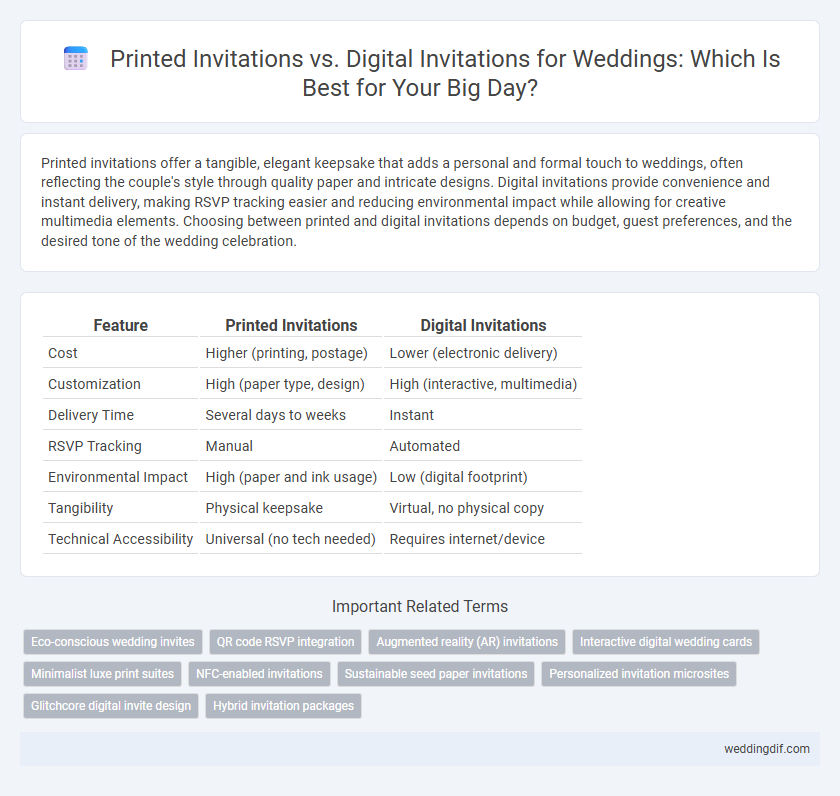Printed invitations offer a tangible, elegant keepsake that adds a personal and formal touch to weddings, often reflecting the couple's style through quality paper and intricate designs. Digital invitations provide convenience and instant delivery, making RSVP tracking easier and reducing environmental impact while allowing for creative multimedia elements. Choosing between printed and digital invitations depends on budget, guest preferences, and the desired tone of the wedding celebration.
Table of Comparison
| Feature | Printed Invitations | Digital Invitations |
|---|---|---|
| Cost | Higher (printing, postage) | Lower (electronic delivery) |
| Customization | High (paper type, design) | High (interactive, multimedia) |
| Delivery Time | Several days to weeks | Instant |
| RSVP Tracking | Manual | Automated |
| Environmental Impact | High (paper and ink usage) | Low (digital footprint) |
| Tangibility | Physical keepsake | Virtual, no physical copy |
| Technical Accessibility | Universal (no tech needed) | Requires internet/device |
Introduction: The Evolution of Wedding Invitations
Wedding invitations have evolved from traditional printed cards to modern digital formats, reflecting advances in technology and changing preferences. Printed invitations offer a tangible keepsake with intricate designs and textures that convey elegance, while digital invitations provide convenience, instant delivery, and interactive features such as RSVP tracking. The choice between printed and digital invitations depends on factors like budget, guest demographics, and environmental considerations.
Cost Comparison: Printed vs. Digital Invitations
Printed wedding invitations typically incur higher costs due to expenses for paper quality, printing techniques, and postage, often ranging from $2 to $10 per invitation depending on customization. Digital invitations offer a cost-effective alternative, with prices averaging between $0.10 and $1 per invite, as they eliminate printing and mailing fees. Budget-conscious couples often prefer digital invitations to minimize expenses without sacrificing design and personalization options.
Environmental Impact: Paper vs. Pixels
Printed wedding invitations consume significant natural resources, including trees and water, contributing to deforestation and water waste in the production process. Digital invitations drastically reduce environmental impact by eliminating paper use, lowering carbon emissions linked to transportation and printing. Choosing electronic invites supports sustainable wedding practices by minimizing landfill waste and conserving energy.
Personalization and Design Flexibility
Printed wedding invitations offer tangible quality and intricate design elements such as embossing, foil stamping, and textured papers, providing a highly personalized and elegant experience. Digital invitations allow unlimited design flexibility with dynamic animations, instant customization, and easy integration of multimedia elements, enhancing interactivity and real-time updates. Both formats support personalized messaging, but printed invitations excel in physical craftsmanship while digital options excel in creative adaptability.
Formality and Guest Perception
Printed wedding invitations convey a timeless formality that often elevates guests' perception of the event's significance. Digital invitations provide convenience and eco-friendliness but may be perceived as less formal, influencing guests' expectations of the wedding's atmosphere. Choosing between printed and digital invitations impacts not only style but also the perceived tone and prestige of the celebration.
Ease of Distribution and RSVPs
Printed wedding invitations offer a tactile and traditional experience but require more time and cost for mailing, making distribution slower compared to digital invitations. Digital invitations enable instant sending via email or social media platforms, allowing couples to reach a wider audience quickly and reduce postage expenses. Online RSVP tracking tools streamline guest responses, providing real-time updates and simplifying event planning logistics.
Keepsake Value: Tangibility vs. Temporality
Printed wedding invitations offer a tangible keepsake with high sentimental value, often preserved in albums or frames as lasting mementos. In contrast, digital invitations provide immediacy and convenience but lack physical presence, leading to lower long-term preservation. The choice between printed and digital invitations significantly impacts the emotional and archival value attached to wedding memories.
Customization Options and Features
Printed invitations offer extensive customization options, including textured paper, embossing, foil stamping, and hand-calligraphy, providing a tactile and elegant experience. Digital invitations allow dynamic features such as animated designs, RSVP tracking, and integrated multimedia like videos or photo galleries, enhancing interactivity and convenience. Both formats enable personalized messaging and thematic elements, but printed invitations excel in physical artistry while digital invites emphasize real-time updates and guest engagement tools.
Accessibility and Recipient Preferences
Printed invitations offer tactile appeal and are preferred by recipients who value traditional keepsakes, but they may lack accessibility for those with visual impairments or mobility challenges. Digital invitations enhance accessibility by incorporating features like adjustable font sizes, screen reader compatibility, and instant delivery, catering to diverse recipient needs. Understanding guest preferences and accessibility requirements ensures the chosen invitation format fosters inclusivity and effective communication.
The Future of Wedding Invitations: Trends and Predictions
Printed invitations continue to offer a timeless, tactile experience with elegant designs and high-quality materials, appealing to couples valuing tradition and formality. Digital invitations are rapidly advancing, integrating interactive features, instant RSVP tracking, and eco-friendly benefits that cater to tech-savvy and environmentally conscious couples. Future wedding invitations will likely blend augmented reality and personalized digital content, enhancing guest engagement while maintaining customization options inherent in printed formats.
Printed invitations vs digital invitations for weddings Infographic

 weddingdif.com
weddingdif.com